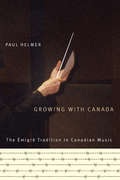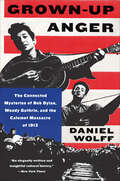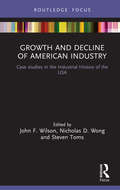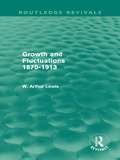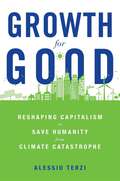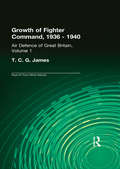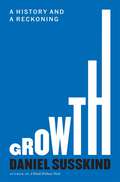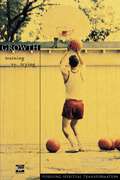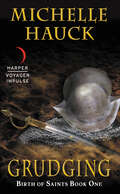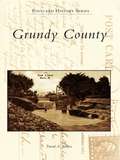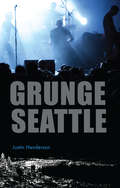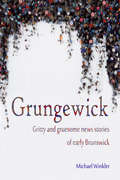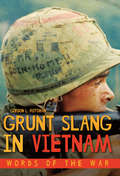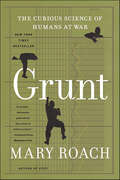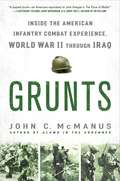- Table View
- List View
Growing with Canada
by Paul HelmerBased on years of detailed and extensive interviews, and supplemented by a wide range of archival material, Growing with Canada showcases the men and women who came to Canada and the roles they played in developing the country's musical culture. Paul Helmer shows that émigrés were at the centre of the new musical milieu and uses the lively testimony of those involved to weave together the larger story of post-war Canadian music performance, production, and education. By introducing the sounds and techniques of their homelands, émigré artists were able to overcome the dominating British presence in post-secondary music education - vastly expanding the role music played in universities - while pioneering the performance and production of opera in Canada. From British Columbia to Newfoundland, they served as educators, teachers, and administrators as well as outstanding performers, conductors, composers, music historians, radio and television producers, and benefactors.
Growing with Canada: The Émigré Tradition in Canadian Music (Arts Insights Series #6)
by Paul HelmerBased on years of detailed and extensive interviews, and supplemented by a wide range of archival material, Growing with Canada showcases the men and women who came to Canada and the roles they played in developing the country's musical culture. Paul Helmer shows that émigrés were at the centre of the new musical milieu and uses the lively testimony of those involved to weave together the larger story of post-war Canadian music performance, production, and education. By introducing the sounds and techniques of their homelands, émigré artists were able to overcome the dominating British presence in post-secondary music education - vastly expanding the role music played in universities - while pioneering the performance and production of opera in Canada. From British Columbia to Newfoundland, they served as educators, teachers, and administrators as well as outstanding performers, conductors, composers, music historians, radio and television producers, and benefactors.
Grown-Up Anger: The Connected Mysteries of Bob Dylan, Woody Guthrie, and the Calumet Massacre of 1913
by Daniel WolffA brilliantly intertwined account of two revolutionary musicians, a miners’ strike, and a deadly tragedy: “Reads like a historical detective story.” —The New York Times Book ReviewAt thirteen, when he first heard Bob Dylan’s “Like a Rolling Stone,” Daniel Wolff recognized the sound of anger. When he later discovered “Song for Woody,” Dylan’s tribute to folk musician Woody Guthrie, Wolff fixed on it as a clue to a distinctive mix of rage and compassion. That clue led back to Guthrie’s “1913 Massacre”—a memorial song about the horrific conclusion to a union Christmas party in Calumet, Michigan.Following the trail from Dylan to Guthrie to a tragedy that claimed seventy-four lives, Wolff found himself tracing a century-long line of anger. From America’s early industrialized days up to the present, the battle over economic justice keeps resurfacing: on a freight car in California, on a joyride through New Orleans, in a snowy field in Michigan. At the stunning conclusion—as the mysteries of Dylan, Guthrie, and the 1913 tragedy connect—the reader discovers a larger story, purposely distorted and buried in time.A tour de force of storytelling years in the making that chronicles the struggles between the haves and have-nots, Grown-Up Anger is both a dual biography of two legendary songwriters and a murder mystery. It also serves as a history of labor relations and socialism, big business and greed in twentieth-century America—all woven together in one epic saga.“A fascinating and relevant whirlwind examination of music, economic injustice, and two American icons.” —Booklist (starred review)“A masterful tale of music, social, and economic history . . . A dazzling, richly researched story impeccably told.” —Kirkus Reviews (starred review)
Growth and Decline of American Industry: Case studies in the Industrial History of the USA (Routledge Focus on Industrial History)
by John F. Wilson Steven Toms Nicholas D. WongThis shortform book presents key peer-reviewed research selected by expert series editors and contextualised by new analysis from each author on how the specific field addressed has evolved. The book features contributions on the history of government-business relations, regional and local business relationships, the development and formation of Silicon Valley, and the rise and fall of the US machine tool industry after the Second World. Of interest to business and economic historians, this shortform book also provides analysis that will be valuable reading across the social sciences.
Growth and Development of Khasi and Garo Languages
by C. R. Marak J. S. Shangpliang"Growth and Development of Khasi and Garo Languages: A collection of papers presented in the seminar held on 28-29 March 2001", edited by C. R. Marak and J. S. Shangpliang. Meghalaya, a northeastern state in India, recognized Khasi and Garo as co-official languages of the state in 2005.
Growth and Fluctuations 1870-1913 (Routledge Revivals)
by W. Arthur LewisIn this title, first published in 1978, Sir Arthur Lewis considers the development of the international economy in the forty years leading up to the First World War, with the adoption of the gold standard, a rapid growth in world trade, the opening up of the continents by the railways, vast emigration from Europe, India and China, and large-scale international investment. The book contrasts the relationship between prices, industrial fluctuations, agricultural output, and the stock of monetary gold, considering both the varying patterns of leading economies and then their net combined effect on the rest of the world. This is history which illuminates the contemporary economic climate in which it was written but also casts light upon our current economic crisis.
Growth for Good: Reshaping Capitalism to Save Humanity from Climate Catastrophe
by Alessio TerziFrom the front lines of economics and policymaking, a compelling case that economic growth is a force for good and a blueprint for enrolling it in the fight against climate change. Economic growth is wrecking the planet. It’s the engine driving climate change, pollution, and the shrinking of natural spaces. To save the environment, will we have to shrink the economy? Might this even lead to a better society, especially in rich nations, helping us break free from a pointless obsession with material wealth that only benefits the few? Alessio Terzi takes these legitimate questions as a starting point for a riveting journey into the socioeconomic, evolutionary, and cultural origins of our need for growth. It’s an imperative, he argues, that we abandon at our own risk. Terzi ranges across centuries and diverse civilizations to show that focus on economic expansion is deeply interwoven with the human quest for happiness, well-being, and self-determination. Growth, he argues, is underpinned by core principles and dynamics behind the West’s rise to affluence. These include the positivism of the Enlightenment, the acceleration of science and technology and, ultimately, progress itself. Today growth contributes to the stability of liberal democracy, the peaceful conduct of international relations, and the very way our society is organized through capitalism. Abandoning growth would not only prove impractical, but would also sow chaos, exacerbating conflict within and among societies. This does not mean we have to choose between chaos and environmental destruction. Growth for Good presents a credible agenda to enroll capitalism in the fight against climate catastrophe. With the right policies and the help of engaged citizens, pioneering nations can set in motion a global decarbonization wave and in parallel create good jobs and a better, greener, healthier world.
Growth of Fighter Command, 1936-1940: Air Defence of Great Britain, Volume 1 (Royal Air Force Official Histories)
by T.C.G. JamesThe first of two volumes of the classified Air Historical Branch study of Fighter Command and the Air Defence of the United Kingdom. It covers pre-war expansion of the Command, the creation of the first integrated air defence system, and an account of Dunkirk and the Battle of Britain.
Growth of a Man
by Mazo de la RocheFrom the author of the bestselling Jalna series. Shaw Manifold is a born forester, of hardy stock. A fatherless boy of nine, he was brought up in the rugged environment of his grandfather’s farm, a lonely youngster in the midst of callous elders. His only ally was his mother, Cristabel, whose work removed her to a distant city. Mother and son lived for their reunions: their private world was a tortured and nostalgic place, but its love braced Shaw against the exhaustion of overwork and the interminable feud with his grandparents from which he escaped to his school of forestry and the Canadian woods. Then at the outset of a brilliant career he found he had overreached his strength. In sickbed and sanatoriums he began to fight the greatest battle of his life. With his courage and endurance, Shaw tells of his relationship with his mother, of his defiance of the Gowers, of his love for Elspeth Blair, and of the expeditions that led to his greatest challenge yet.
Growth of the International Economy, 1820-2015
by Michael Graff A. G. Kenwood A. L. LougheedKenwood and Lougheed’s classic book has been the benchmark introduction to the development of the global economy for decades. For this fifth edition, Michael Graff has brought the story up to date to include events from the early part of the twenty first century – continued globalization, the emergence of Asia as an economic power and the greater role played by business on the international scene. Beginning with the industrial revolution, the book charts the long nineteenth century, the impact of colonialism, the fast pace of technology growth and the impact of global wars. New features to this edition include: a prologue explaining the initial conditions faced by the world economy in 1820, detailing the beginnings of international trade and the influence of slavery greater coverage of developing countries increased coverage of World Wars I and II and of the twentieth century a number of appendices outlining the economic concepts and theories underlying the text This new edition of Growth of the International Economy provides the reader with a clear understanding of the factors which have been instrumental in creating the economic environment we face two hundred years after the industrial revolution.
Growth: A History and a Reckoning
by Daniel SusskindA vivid account of the past, present, and future of economic growth, showing how and why we must continue to pursue it while responding to the challenges it creates.Over the past two centuries, economic growth has freed billions from the struggle for subsistence and made our lives far healthier and longer. Yet prosperity has come at a price: environmental destruction, desolation of local cultures, the rise of vast inequalities and destabilizing technologies. Faced with such damage, many now claim that the only way forward is through “degrowth,” deliberately shrinking our economic footprint. But to abandon humanity’s progress would be folly. Instead, Daniel Susskind argues, we must keep growth but redirect it, making it better reflect what we truly value.In a sweeping analysis full of historical insight, Susskind shows how policymaking came to revolve around a single-minded quest for greater GDP. This is a surprisingly recent development: economic growth was barely discussed until the second half of the twentieth century. And our understanding of what drives it is more recent still. Only lately have we come to see how humankind emerged from its millennia of stagnation: through the sustained discovery of powerful and productive new ideas.This insight undermines the mantra that “we cannot have infinite growth on a finite planet,” for the world of ideas is infinitely vast. Yet growth’s critics are right to insist that we can no longer focus on its upsides alone. We must confront the tradeoffs, Susskind contends: sometimes, societies will have to deliberately pursue less growth for the sake of other goals. These will be moral decisions, not simply economic ones, demanding the engagement not just of politicians and experts but of all citizens.
Growth: From Microorganisms to Megacities (The\mit Press Ser.)
by Vaclav SmilA systematic investigation of growth in nature and society, from tiny organisms to the trajectories of empires and civilizations.Growth has been both an unspoken and an explicit aim of our individual and collective striving. It governs the lives of microorganisms and galaxies; it shapes the capabilities of our extraordinarily large brains and the fortunes of our economies. Growth is manifested in annual increments of continental crust, a rising gross domestic product, a child's growth chart, the spread of cancerous cells. In this magisterial book, Vaclav Smil offers systematic investigation of growth in nature and society, from tiny organisms to the trajectories of empires and civilizations. Smil takes readers from bacterial invasions through animal metabolisms to megacities and the global economy. He begins with organisms whose mature sizes range from microscopic to enormous, looking at disease-causing microbes, the cultivation of staple crops, and human growth from infancy to adulthood. He examines the growth of energy conversions and man-made objects that enable economic activities—developments that have been essential to civilization. Finally, he looks at growth in complex systems, beginning with the growth of human populations and proceeding to the growth of cities. He considers the challenges of tracing the growth of empires and civilizations, explaining that we can chart the growth of organisms across individual and evolutionary time, but that the progress of societies and economies, not so linear, encompasses both decline and renewal. The trajectory of modern civilization, driven by competing imperatives of material growth and biospheric limits, Smil tells us, remains uncertain.
Growth: Training vs. Trying (Pursuing Spiritual Transformation)
by John Ortberg Laurie Pederson Judson PolingWhat would your life be like if Jesus lived it? Imagine the change you would experience in your thoughts, actions, and relationships. Think of the joy and freedom that could transform every area of your life. That’s exactly what God has in mind for you! You’ll find out how in Growth. Through personal study and small group interaction, this study sets you on a path to live out the character of Jesus in this world as only you can. It happens not by trying hard, but by training. By cultivating spiritual disciplines--Scripture meditation, prayer, solitude, endurance, loving others--you’ll discover the joy of being transformed by Christ and the freedom of living each day sustained by his power. Leader’s guide included!Growth group sessions are:Training to Live Like JesusThe Practice of Scripture MeditationThe Practice of SolitudeSimple PrayerThree Transforming PrayersThe Roundabout WayAnd the Greatest of These Is Love
Grudging: Birth Of Saints Book One (Birth of Saints)
by Michelle HauckA lyrical tale of honor and magic, Grudging is the opening salvo of Michelle Hauck's the Book of Saints trilogy that combines the grace of Ellen Kushner's Swordpoint with the esprit de corps of Django Wexler's Shadow Campaign series.A world of chivalry and witchcraft…and the invaders who would destroy everythingThe north has invaded, bringing a cruel religion and no mercy. The ciudades-estados who have stood in their way have been razed to nothing, and now the horde is before the gates of Colina Hermosa…demanding blood.On a mission of desperation, a small group escapes the besieged city in search of the one thing that might stem the tide of Northerners: the witches of the southern swamps.The Women of the Song.But when tragedy strikes their negotiations, all that is left is a single untried knight and a witch who has never given voice to her power. And time is running out.
Gruesome Looking Objects: A New History of Lynching and Everyday Things (Cambridge Studies on the American South)
by Elijah GaddisThe 1898 lynching of Tom Johnson and Joe Kizer is retold in this groundbreaking book. Unlike other histories of lynching that rely on conventional historical records, this study focuses on the objects associated with the lynching, including newspaper articles, fragments of the victims' clothing, photographs, and souvenirs such as sticks from the hanging tree. This material culture approach uncovers how people tried to integrate the meaning of the lynching into their everyday lives through objects. These seemingly ordinary items are repositories for the comprehension, interpretation, and commemoration of racial violence and white supremacy. Elijah Gaddis showcases an approach to objects as materials of history and memory, insisting that we live in a world suffused with the material traces of racial violence, past and present.
Grumman F-14 Tomcat: Bye-Bye Baby. . . !
by George Hall Dave Parsons Bob LawsonA look back at the jet fighter’s thirty-five years of service with the US Navy, featuring hundreds of photos as well as stories from pilots.For thirty-five years of active naval service, the Grumman F-14 Tomcat was the foremost air superiority fighter of the Cold War, with continuing service as a fighter-bomber in the Gulf Wars. Two hundred thousand sailors, both pilots and “ground” crew, served in F-14 squadrons with the Tomcat over its decades of flight.This book is a grand remembrance of this great aircraft by those who flew it. Hundreds of pilots have included their favorite stories of the missions and planes that brought them home. Two hundred exceptional color photographs show the F-14 on the deck, in the air, and over the sea.
Grundlagen der Politischen Theorie: Ein Überblick
by Michael HausDas Lehrbuch verbindet eine bewährte Orientierung an Schlüsselautor*innen mit einer innovativ-systematischen Darstellungsweise. Mit dem Verständnis von Politischer Theorie als Systematisierung der Rechtfertigung und Kritik politischer Verhältnisse wird ein weiter, aber zugleich eingegrenzter Fokus gesetzt. Im ersten Teil („Klassische Perspektiven“) werden jeweils zwei Figuren der politischen Ideengeschichte kapitelweise gegenübergestellt. Auch im zweiten Teil („Zeitgenössische Perspektiven“) werden zentrale Argumentationsansätze mittels einer vergleichenden Betrachtung von Theoretiker*innen erschlossen. Darüber hinaus werden Forderungen nach einer grundlegenden Neuausrichtung der Politischen Theorie behandelt. Eine übergreifende Klammer bilden Reflexionen zu den Konzepten „Macht“, „Gerechtigkeit“ und „Demokratie“.
Grundy County (Postcard History)
by David A. BeldenIn 1673, Louis Jolliet and Fr. Jacques Marquette were the first Europeans to explore the Mississippi River and the Illinois River valleys. With their canoes loaded with furs, pelts, and other goods on their return trip to Montreal, their explorations through much of the interior of Illinois included encounters with Native American tribes and took them through what is now Grundy County. Over 150 years later, the first permanent residents, including William Marquis, began settling and farming in the area. While the chief occupation of the residents is agriculture, the county also has the Illinois River and the Illinois and Michigan Canal that pass through its northern sections, as well as the Rock Island and the Chicago and Alton Railways. With communities rich in history and small-town charm, Grundy County continues to draw visitors and residents to its towns, parks, museums, rivers, and lakes. Grundy County attempts to reveal this unique county and its sense of community and pride.
Grunge Seattle
by Justin HendersonDetailing the intertwined lives of members of core grunge bands, this thoroughly researched account reveals the origins and inspirations of the grunge music movement. Illustrating the dramatic and emotional tensions that arose between the various players, it describes the collisions between personalities and egos, artists and corporations, suburbs and cities, obscurity and fame. It is also a unique guide to the key locations in the grunge story, exploring the cafes, apartments, and studios where members of bands such as Nirvana, Pearl Jam, Soundgarden, Mudhoney, and Alice in Chains practiced and played.
Grunge Seattle
by Justin HendersonChronicling the intertwined lives of members of core grunge bands, Grunge Seattle reveals the origins and inspirations of the grunge movement. Delve into the collisions between personalities and egos, artists and corporations, suburbs and cities, obscurity and fame. Explore the cafés, apartments and studios where Nirvana, Pearl Jam, Soundgarden, Mudhoney and Alice in Chains practiced and played. In this reprint edition, originally published in 2010 and revised in 2016, writer, surfer and longtime Seattlite Justin Henderson provides a unique guide to the key locations in the story of grunge.
Grungewick
by Michael WinklerMurder. Mayhem. Misdeeds. In the nineteenth century, Brunswick was a satellite suburb of Melbourne. While the big city boomed, Brunswick was a place of "bricks and pottery, mud and poverty" with the unruliness of a frontier town. This collection of contemporary newspaper stories provides a vivid picture of the seamy side of life in 1800s Brunswick. It includes famous outrages such as the trial and execution of 'baby farmer' Frances Knorr; Mary Ryckman attacking her neighbour with dynamite; and the outbreak of Irish sectarian violence in Sydney Road. It also captures lesser-known incidents that, together, portray a much harder time: street larrikins, pub brawls, industrial deaths, poisoning both accidental and deliberate. Grungewick provides an unusual window into Australian life in the 1800s and shows that, even when times are toughest, the dignity and resilience of everyday people can shine through.
Grunt Slang in Vietnam: Words of the War
by Gordon L. RottmanA look at how combat, culture, and military tradition influenced soldiers&’ language in Vietnam from the award-winning, USA Today–bestselling author. The slang, or unique vocabulary, of the soldiers and marines serving in Vietnam, was a mishmash of words and phrases whose origins reached back to the Korean War, World War II, and even earlier. Additionally, it was influenced by the United States&’ rapidly changing protest culture, ideological and poetical doctrine, ethical and cultural conflicts, racialism, and drug culture. This &“slanguage&” was rendered even more complex by the Pidgin Vietnamese-English spoken by Americans and Vietnamese alike. But perhaps most importantly, it reflected the soldiers&’ actual daily lives, played out in the jungles, swamps, and hills of Vietnam.
Grunt: The Curious Science of Humans at War
by Mary RoachA finalist for the Los Angeles Times Science & Technology Book Prize &‘The most entertaining writer in science&’ – The Times, Books of the Year War. Mention it and most of us think of history, of conflicts on foreign soil, of heroism and compromise, of strategy and weapons. But there&’s a whole other side to the gruesome business of the battlefield. In Grunt, the inimitable Mary Roach explores the science of keeping human beings intact, awake, sane, uninfected and uninfested in the bizarre and extreme circumstances of war. Setting about her task with infectious enthusiasm, she sniffs World War II stink bombs, tests earplugs in a simulated war zone and burns the midnight oil with the crew of a nuclear submarine. Speaking to the scientists and the soldiers, she learns about everything from life-changing medical procedures to innovations as esoteric as firing dead chickens at fighter jets. Engrossing, insightful and laugh-out-loud funny, this is an irresistible ride to the wilder shores of modern military life.
Grunt: The Curious Science of Humans at War
by Mary RoachA New York Times / National Bestseller "America's funniest science writer" (Washington Post) Mary Roach explores the science of keeping human beings intact, awake, sane, uninfected, and uninfested in the bizarre and extreme circumstances of war.Grunt tackles the science behind some of a soldier's most challenging adversaries—panic, exhaustion, heat, noise—and introduces us to the scientists who seek to conquer them. Mary Roach dodges hostile fire with the U.S. Marine Corps Paintball Team as part of a study on hearing loss and survivability in combat. She visits the fashion design studio of U.S. Army Natick Labs and learns why a zipper is a problem for a sniper. She visits a repurposed movie studio where amputee actors help prepare Marine Corps medics for the shock and gore of combat wounds. At Camp Lemmonier, Djibouti, in east Africa, we learn how diarrhea can be a threat to national security. Roach samples caffeinated meat, sniffs an archival sample of a World War II stink bomb, and stays up all night with the crew tending the missiles on the nuclear submarine USS Tennessee. She answers questions not found in any other book on the military: Why is DARPA interested in ducks? How is a wedding gown like a bomb suit? Why are shrimp more dangerous to sailors than sharks? Take a tour of duty with Roach, and you’ll never see our nation’s defenders in the same way again.
Grunts
by John C. McmanusIn Grunts, renowned historian John C. McManus demonstrates that, from the invasion beaches of the Second World War to the deserts of the Middle East, the foot soldier has been the most indispensible-and most overlooked-factor in wartime victory. Advances in weaponry have threatened to render the infantryman obsolete for centuries. Even today, precision-guided munitions, nuclear bombs, aerial drones, computers, and satellites have made victory in modern warfare seem like a simple matter of superior hardware, negating the need for ground soldiers. In truth, even as technology advanced at a dizzying pace throughout the twentieth and early twenty-first centuries, ground soldiers, especially infantry "grunts," did almost all of the fighting and dying in America's wars. Examining ten critical battles, McManus covers six decades of warfare-from the 1944 fight on the island of Guam to today's counterinsurgency combat in Iraq-in which the skills and courage of American troops proved the crucial difference between victory and defeat. Penetrating the flowery rhetoric of headlines and standard battle narratives, McManus exposes the shocking brutal realities of modern ground combat. Based on years of archival research and personal interviews with veterans, this powerful history reveals the ugly face of war in a way that few books have. Gruntsdemonstrates the vital, and too often forgotten, importance of the human element in protecting the American nation, and advances a passionate plea for fundamental change in our understanding of war.
